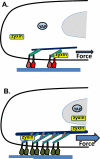Integrins in mechanotransduction
- PMID: 23797029
- PMCID: PMC3757118
- DOI: 10.1016/j.ceb.2013.05.006
Integrins in mechanotransduction
Abstract
Forces acting on cells govern many important regulatory events during development, normal physiology, and disease processes. Integrin-mediated adhesions, which transmit forces between the extracellular matrix and the actin cytoskeleton, play a central role in transducing effects of forces to regulate cell functions. Recent work has led to major insights into the molecular mechanisms by which these adhesions respond to forces to control cellular signaling pathways. We briefly summarize effects of forces on organs, tissues, and cells; and then discuss recent advances toward understanding molecular mechanisms.
Copyright © 2013 Elsevier Ltd. All rights reserved.
Figures


References
-
- Yashiro K, Shiratori H, Hamada H. Haemodynamics determined by a genetic programme govern asymmetric development of the aortic arch. Nature. 2007;450:285–8. - PubMed
-
- Sabine A, Agalarov Y, Maby-El Hajjami H, et al. Mechanotransduction, PROX1, and FOXC2 cooperate to control connexin37 and calcineurin during lymphatic-valve formation. Dev Cell. 2012;22:430–445. [This paper demonstrates that lymphatic endothelial cells’ initiate valvel formation in response to oscillatory fluid shear stress, through induction of the transcription factors PROX1 and FOXC2.] - PubMed
Publication types
MeSH terms
Substances
Grants and funding
LinkOut - more resources
Full Text Sources
Other Literature Sources

